The Work We Do...
Water Quality Changes in Southwest Alaskan Lakes
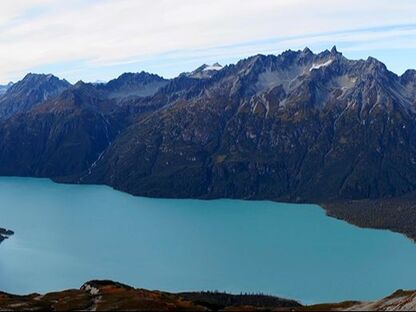 Crescent Lake in Lake Clark National Park and Preserve. Photo Credit: W. Hill, NPS.
Crescent Lake in Lake Clark National Park and Preserve. Photo Credit: W. Hill, NPS.
Lakes in national parks in Southwest Alaska have been monitored for water quality on a for at least a decade, with lakes re-sampled semi-regularly across years. These measures may hold interesting patterns related to long-term change due to climate or other impacts, but they have not been assessed. We will be carrying out a synthesis of these data to understand potential spatial and temporal gradients in water quality across and within these lakes, group these lakes along any identifiable suite of conditions, and forecast future change in these ecosystems given future environmental conditions. This work is funded by the Southwest Alaska Inventory and Monitoring Network. This project is being led in our lab by Dr. Matt Dunkle.
Fish Parasites on Pacific Salmon
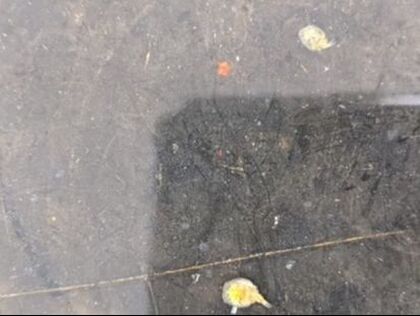 Sea lice extracted from a preserved Coho salmon museum specimen. Photo Credit: Alexa Wing.
Sea lice extracted from a preserved Coho salmon museum specimen. Photo Credit: Alexa Wing.
Macroinvertebrate ectoparasites, such as the copepods commonly referred to as sea lice, are relatively common on fish, including Pacific salmon. However, these ectoparasites are rarely quantified or even documented, so our ability to understand any changes in their distributions (such as due to climate change) and their impacts on fisheries over time is poorly understood. In this project, we are utilizing museum specimens of all five Pacific salmon species stored at the University of Alaska Museum of the North to determine the ectoparasite load on these preserved, historical specimens. We are also piloting utilizing DNA extraction approaches to see if we can understand parasite loads in these specimens utilizing only the ethanol the fish are preserved in (non-destructively!) This work is funded by the NIH Veterinary Summer Scholars Program at Colorado State University and is being carried out in collaboration with Dr. Morag Clinton. In our lab, Alexa Wing worked on this project as part of her veterinary science summer fellowship.
Long-term Change in Aquatic Insects and Water Quality in Alaska
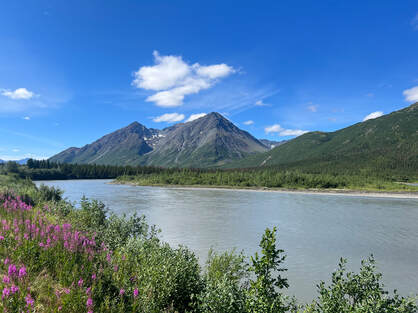 In Denali National Park.
In Denali National Park.
Aquatic insect communities are often used as sentinels of change in freshwaters, yet these communities are poorly studied in Alaska. Using a long-term dataset from public lands in central Alaska, particularly within national parks, we will be synthesizing aquatic invertebrate and water quality data to address changes in community structure and composition over time, and how these changes are related to environmental conditions. We are particularly interested in understanding if these communities can be predicted by (or, conversely, can be used to predict) environmental conditions, and how community structure and spatial use of habitats may be changing due to climate change and in-stream mining activities. This work is funded by the National Park Service Central Alaska Inventory and Monitoring Network. This project is being led in our lab by Dr. Caleb Robbins.
Stream Restoration Effectiveness in Alaska
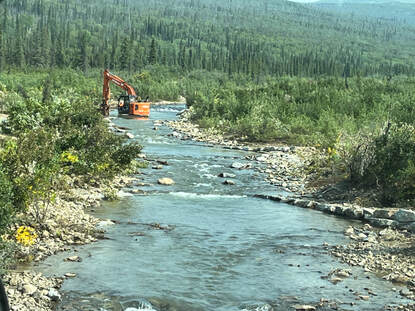 Stream restoration on Nome Creek, Alaska.
Stream restoration on Nome Creek, Alaska.
Streams and rivers in Alaska, like elsewhere in the United States, are a focus of ecological restoration activities to return degraded ecosystems to a more ecologically healthy condition. Unlike elsewhere in the US, stream restoration effectiveness in Alaska has not been robustly assessed. Our goals in this project are to utilize approaches, such as the Stream Quantification Tool (SQT) on restored streams in Interior Alaska and to see what functional "lift" these restoration activities provide to the impacted ecosystem. This work is funded in part by the Bureau of Land Management and is in collaboration with the U.S. Fish and Wildlife Service. In our lab, Dakota Keller is working on this project as part of her masters degree.
Boat Wake Impacts on Shorelines and Salmon Habitat
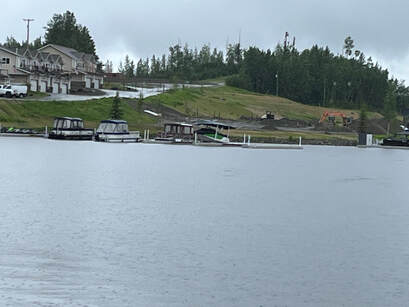 Boats and development with erosion on Big Lake.
Boats and development with erosion on Big Lake.
In Big Lake, Alaska, boats are being created with larger and larger ballast for the purpose of creating deliberately large wakes for watersports (jet skis). Meanwhile, landowners around the lake are concerned that these wakes are eroding their property shorelines, potentially literally undercutting the effectiveness of a popular Federal-State-private cost-share program for bank stabilization and restoration. Big Lake is also an important habitat for Sockeye and Coho salmon spawning, and it is unclear if boat wakes and any associated shoreline erosion are increasing in-lake turbidity and suspended sediment aggradation on salmon redds. Our work here seeks to address the magnitude of these boat wakes on shoreline erosion, turbidity, fine sediment, and, ultimately, salmon spawning habitat across Big Lake. This work is funded by and in collaboration with the USGS/U.S. Fish and Wildlife Service Science Support Program and the Alaska Department of Fish and Game. In our lab, Eli Wilson is working on this project as part of her masters degree, with contributions from Ian Kwit.
Wildfires, Wood, & eDNA
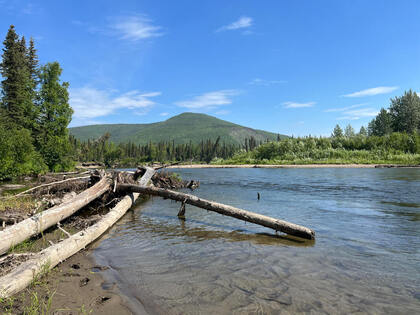 Log jam on the Chena River, Alaska.
Log jam on the Chena River, Alaska.
Wildfires are increasing in frequency and severity due to climate change, and this is particularly apparent in Interior Alaska. Our research has investigated how wildfires may affect the large woody debris that makes its way into larger rivers, especially the composition and form of that large woody debris. We are interested to know if the large wood found in wildfire-burned reaches is simpler (like a telephone pole instead of a tree), less abundant (because burned wood floats better), and consequently yields less viable habitat for salmon and other fish because it gets exported more rapidly. We are also interested in understanding how wildfire may be impacting freshwater communities by comparing sites along a burned/unburned gradient using water samples collected for eDNA. We are testing these hypotheses with fieldwork near Fairbanks (Alaska, USA) in summer 2022 and 2023. This research is funded by Seed grants from Alaska EPSCoR in collaboration with Jeff Falke's lab, Tanana Chiefs Conference, and the U.S. Fish and Wildlife Service. In our lab, Monica Gosselin-Boeman worked on this project as part of her summer research work.
Aquatic Food Webs in Grand Canyon
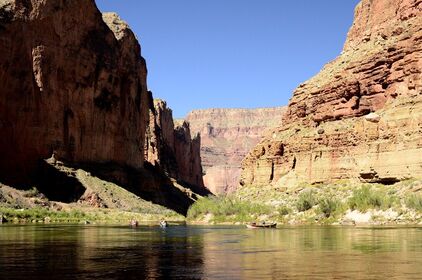 The Colorado River in Grand Canyon. Photo Credit: Joel Sholtes.
The Colorado River in Grand Canyon. Photo Credit: Joel Sholtes.
The Colorado River in Grand Canyon (Arizona, USA) is iconic and also supports several species of native fish, including the threated humpback chub (Gila cypha). Yet the food web that supports these fish is dominated by relatively few species of aquatic insects, at low abundance. While with the USGS Grand Canyon Monitoring and Research Center I (Jeff) was involved in designing and overseeing the research implementation of experimental "Bug Flows," an experiment with associated monitoring that continues into this year. Bug Flows provide stable, low weekend flow releases from Glen Canyon Dam upstream that are intended to provide ideal conditions for aquatic insect egg-laying and survival. This research is funded primarily by the Glen Canyon Dam Adaptive Management Program overseen by the U.S. Bureau of Reclamation.
Ecological Subsidies and Riparian Buffers
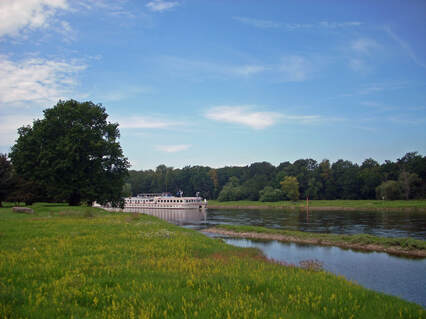 The Elbe River, Germany
The Elbe River, Germany
Rivers receive energy from the land in the form of leaves and other debris and return energy back to terrestrial food webs in the form of highly-nutritious animal biomass (insects, fish carcasses, etc.) I (Jeff) remain interested in quantifying the magnitude of this flux, both in terms of total energy and in terms of the distance that energy is transferred out of the river (what I call the "stream signature"). I am also fascinated by the interplay between these subsidies, both into and out of the river, and the structure and composition of riparian zones, specifically how riparian buffers may promote this ecosystem function.
Banner Photo Credit: Monica Gosselin-Boeman.
